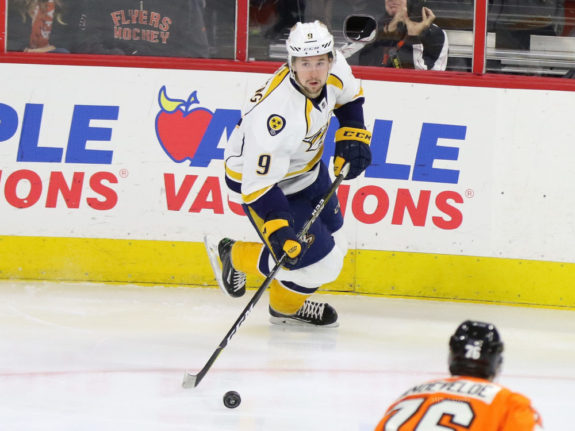Under normal circumstances, five games into the season might not be the time to push the panic button for any National Hockey League team, and by no means are the Nashville Predators currently a team that should push the button yet. However, a shortened 56-game season means that teams may start reaching for the button earlier than normal. After an opening series sweep against the Columbus Blue Jackets, Nashville followed it up with a disappointing loss against Carolina before looking like a team in the early stages of a rebuild against the Dallas Stars, who were playing their first games of the season.
While being outscored 10-2 in the two-game series against the Stars, Nashville struggled mightily in all areas of their game, but particularly in the offensive zone. While they recorded 51 shots on goal in the two games against the 2019-20 Stanley Cup finalists, the Predators failed to generate consistent offense and quality scoring chances. In Sunday night’s game, Nashville went over 21 minutes without a shot on goal, recording only three in the second period and 17 in the game.
While the panic button is not one that general manager David Poile is likely to press for a while – panic buttons in the NHL usually mean trading players for future assets – head coach John Hynes can certainly try to shake things up. The forward lines in particular can use some mixing and matching, as the top twelve is deep with talent and skill, but stuck in a rut right now. With a pair of games coming up against the Chicago Blackhawks and their Central Division-worst defense, this seems an opportune time to test some new line combinations, as outlined below.
Granlund – Duchene – Forsberg
The “JOFA” line of Ryan Johansen, Filip Forsberg and Viktor Arvidsson has shown some flashes of re-discovering their scoring touch, but really Forsberg is the only one who has done so consistently and should maintain, at least for now, his spot on the top line.
Mikael Granlund has played about 20 minutes in a pair of games since entering the lineup, and his speed and skill could be a great fit on the wing opposite Forsberg. Matt Duchene hasn’t looked bad on the second line, but boosting him to the top line could inspire a little burst from the former-30 goal scorer. With two skilled snipers flanking him, Duchene could become the number one center he was, at times, in both Colorado and Ottawa.

Forsberg has probably been the most consistent Predator in the offensive zone, with goals in four of the five games thus far. He leads the Predators in shot attempts and takeaways and leads all regular forwards in ice time. He might benefit from a change of company, at least temporarily, in order to further improve his offensive success and maybe light a fire under the rest of the JOFA line.
Haula – Johansen – Arvidsson
Johansen and Arvidsson have not been bad, but inserting someone like Erik Haula on the wing could prove to boost all three players. He has been buried on the third line with the return of Granlund and is definitely worthy of being given top-six minutes.
It’s easy to look at Haula’s production over his career and claim inconsistency has been his downfall, but a closer examination proves that he has scored more when he has played more. It sounds really simple, but I think it really is that simple, and promoting him to the second line (again) gives him both the minutes and linemates that could allow him more opportunities to score.

Johansen has seemed lethargic at times, but he’s been virtually cemented on Nashville’s top line since arriving in the Music City via trade in January 2016. It could be time to swallow some pride and “demote” him to the second line, in order to add some extra motivation to the 28-year old.
He wouldn’t be without skilled companions, as he has proven in the past to have good chemistry with Arvidsson, and Haula, as mentioned, could benefit from more minutes and linemates with skills comparable to his. Johansen is a big-bodied power forward and could be a good complement to the speed that both Haula and Arvidsson possess. In theory, this could really become more of a 1B line than a true second line, but that is a problem the Predators would love to encounter.
Tomasino/Tolvanen – Jarnkrok/Trenin – Grimaldi
Nashville’s bottom six is where it gets tricky, so bear with me here. They have two really good prospects on their taxi squad, so for the third line winger, choosing one or even rotating the two could prove beneficial for everyone involved.
Philip Tomasino is coming off of a great World Junior Championship for Canada, scoring six points in seven games, and the only season in the Ontario Hockey League where he wasn’t better than a point-per-game player was his rookie season when he was 16 years old. The first-round pick in 2019 has definite scoring potential but has yet to play an NHL game.
Likewise, Eeli Tolvanen is another first-round pick (2017) who has been a proven scorer everywhere he’s played, from the American Hockey League (71 points in 123 games) to the Olympics (nine points in five games in 2018). Now 21 years old with seven NHL games under his belt, Tolvanen could slide into a third-line role, and the presence of either him or Tomasino could put pressure on some of the top six to either start producing or get replaced by a first-round pick.

Calle Jarnkrok’s absence from the third line is, for the time being, understandable, since he is currently day-to-day with an undisclosed injury. A veteran with his two-way talent at both ends of the ice could be a really steadying presence for either one of the aforementioned first-round picks on his wing.
Alternatively, Yakov Trenin would see a boost in his time on the ice as the third line center until Jarnkrok returns, and while his role on this line would be more defensive than offensive, he does have scoring in large quantities in his resume. In three seasons in the Quebec Major Junior Hockey League with Gatineau, Trenin scored 195 points in 169 games.
Rocco Grimaldi has made some mistakes, yes, but so has literally everyone on the Predators’ roster, and his being a healthy scratch in the first Dallas game on Jan. 22 was somewhat of a surprise. The diminutive winger has shown good flashes through the four games he’s played so far, and while third line minutes aren’t necessarily abundant in nature, his speed can certainly have a positive impact with the proposed combination of Jarnkrok and a prospect.
Kunin/Cousins – Richardson – Sissons
Brad Richardson is 35 years old and is averaging nine minutes of ice time at even strength, which probably suits him especially when his biggest role is as a penalty killer.
Colton Sissons is too good to leave out of the lineup, and also carries a cap hit of over $2.8 million, which is tough to bury on your fourth line, but maybe that is the kick in the pants Sissons needs to regain the potential he began to realize in 2018-19 when he scored 15 goals. His role as a penalty killer is also valuable to the Predators, and based on the current state of the penalty kill after the Dallas series, is probably something he and Richardson should allot more focus on.

Luke Kunin and Nick Cousins are interesting dilemmas; neither one is particularly dynamic offensively, and both are averaging around 14 minutes a game. While Kunin is a regular penalty killer, Cousins doesn’t have such a role, so he seems a little out of place on a primarily defensive fourth line. However, he hasn’t had the same jump in his step as Grimaldi, so perhaps limited minutes as a fourth-liner is what he needs for the time being.
Testing out new line combinations can be a tricky thing sometimes, but Nashville has enough skill in their forward lineup that they could be able to adapt quickly. That being said, shaking up the lines could prove to make a positive difference in the Predators’ offensive output over the next few games and benefit them in the long run.